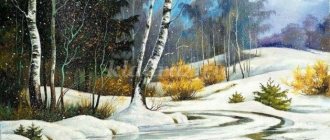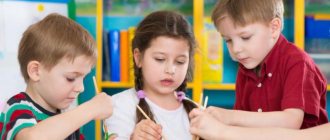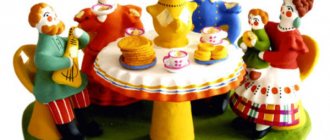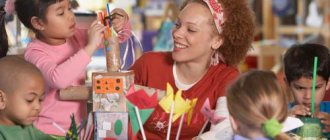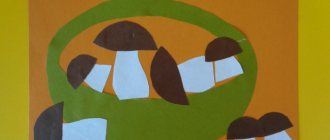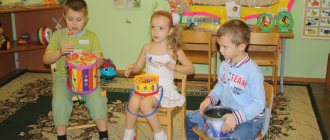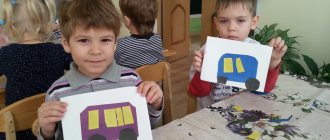Middle group. Junior preschool age. Children 4 - 5 years old
New Year's decoration for the walking section of the middle group "How candy grew on a branch"
Popova Valentina New Year's decoration of the walking area of the middle group “How candy grew on our branch”
There is very little time left before the most magical and beloved holiday of the New Year. Adults and especially children look forward to this holiday...
Observation in the middle group on a walk behind the trees: spruce, thuja
Program objectives : -Expand children’s understanding of trees growing on the site (spruce, thuja)
; expand children's horizons and vocabulary. — Develop observation skills: find similarities and differences. -Cultivate a caring attitude towards nature. Preliminary work:...
Targeted walks and excursions; methodological development of the world around us (middle group) on the topic
Long-term plan of excursions and targeted walks
In the middle group No. 1
September
1 Tour of the kindergarten site. Introduce children to the diversity of the plant world.
2 Targeted walk around the territory of the kindergarten. Let the children understand that the territory of the kindergarten is not limited only to the area where children walk; broaden children's horizons. Activate the vocabulary: territory, flower bed, flower garden. Foster a caring attitude towards nature. Develop labor skills and abilities.
3 Targeted walk to the flower garden.
4 Targeted walk to the preparatory group site. Watch older children play. Cultivate friendly relationships. Develop conversational speech.
October
1 Excursion around the territory of the kindergarten. Develop children's skills, admire the beauty of autumn nature.
2. Targeted walk to the kindergarten park. Expand knowledge about the season - autumn, name the signs of autumn. Consider plants: trees, shrubs, herbs. Note that everything has turned yellow, “Golden Autumn” has arrived
3 Target walk “Feathered Friends”. Consider the birds and their body parts. Activate the words in speech: birds, sparrows, crows, fly, sit, jump, fly over.
4 “Grass-ant”. Note that the grass has withered, late autumn has arrived. Name the characteristic signs of autumn.
November
1 A tour of the streets where the kindergarten is located. Introduce children to the rules of safe behavior on the street. Pay attention to objects (shops, post office, clinic)
2 “We’ll go around the garden.” Consider the kindergarten building. Find group windows. Note that every house has windows, doors and their purpose.
3 “Why are fences needed?” Note with children the purpose of fences, reinforce that you cannot walk behind a fence - life safety.
4 Targeted walk to the music room. Get to know the profession of a music director. He teaches us to sing, dance, play musical instruments, and celebrates holidays. Show musical instruments and play them.
December
1 Excursion to the medical office of the kindergarten. Introduce children to the profession.
2 Target walk to a neighboring site. Introduce neighbors to children. Children's ability to communicate with older children.
3 Target walk “We’ll go around the kindergarten.” Looking at the fallen snow.
4 Target walk “Observation of transport”. Strengthen children's knowledge about types of transport (public, freight, passenger)
January
1 Walking tour. LIFE SAFETY FUNDAMENTALS.
2 Targeted walk to the senior group. Introduce children to the group room of older children. Children's ability to communicate with older children. Orientation in space.
3 Target walk to the snowdrift. Consider the snowdrift that caused it to form (accumulation of snow). Activate the words in speech: snow, blizzard, winter, snowdrift.
4 “Whose trace?” Awaken in children a sense of interest and involvement in everything they see and notice. To develop children’s ability to observe, examine and talk.
February
1 Excursion to the laundry. Introduce the profession.
2 “We will go along the path.” Create a joyful mood about the snowy buildings you see. Activate the words in children's speech: snowman, snowwoman, slide, labyrinth.
3 Target walk to the winter tree. Examine the tree, note that it is bare, there are no leaves, because it is still very cold outside.
4 Target walk “Let’s go around the garden.” Looking at the icicles on the roof. Life safety - why you can’t walk under the roofs of houses and kindergartens, reinforcing safety rules.
March
1 Excursion to the kitchen, introduce the equipment. To introduce the profession and cultivate interest in it.
2 Targeted walk around the site. Expand knowledge about the season - spring. Name the signs of spring (snow melting, the sun is warming up, buds are swelling on the trees, birds are singing like spring).
3 Observation of icicles. See the changes that happen to the icicles, the reasons for the drops. Give signs of spring.
4 "Our birds". Continue observing and examining the birds that have flown to the site.
April
1 Excursion to the birch tree. To consolidate children's knowledge that trees do not die in winter; buds remain on the branches, from which green leaves bloom. Plants need warmth to grow. To develop children’s ability to use examination techniques, to arouse interest in observing trees.
2 “Why are fences needed?” Target walk to the fence. Monitoring passing vehicles. Expand knowledge about types of transport (bus, truck, car). Activate words in children's speech: cabin, body, wheels, steering wheel.
3 Targeted walk around the site. Create a joyful mood. Draw the children's attention to the area, how it has changed. There was a lot of snow, but now it has almost all melted.
4 “Where does the puddle live?” Note why they form in the spring. Why? Encourage statements (melting snow, the sun is warming) Show children a variety of actions with melted snow.
May
1 Excursion around the territory and outside of the kindergarten. To form in children an idea of the diversity of the plant world. Develop the ability to distinguish and name familiar flowering plants. Cultivate a caring attitude towards plants.
2 Target walk to the tree. To develop children’s ability to observe, compare, see a phenomenon in its development, what happened recently, what has happened now. Add the following words to your children's active vocabulary: branch, buds, swollen, young leaves appear.
3 Targeted walk around the site. Examine the first young grass that appears. Expand knowledge about changes in nature.
4 Targeted walk to the garden. Observing the work of adults in the garden. Expand children's knowledge about plants. Show seedlings, seeds. Introduce the words: beds, seedlings, seeds, vegetable garden, watering can.
Walks. Walking notes - Quest game “Help the mouse” on a walk for middle school children
Publication “Quest game “Help the mouse” on a walk for middle-age children...” Goal: to develop interest in a new form of gaming activity (quest game) Objectives: to consolidate ideas about changes in nature, to develop social and communicative qualities through a collective decision, to consolidate counting within 3, consolidate knowledge of geometric figures, ability...
Summary of the lesson “Observing a walk behind a spruce tree” in the middle group
Goal: developing a value attitude towards objects of living nature using the example of a tree - spruce. Objectives: Deepen and systematize children’s knowledge about living nature. To form ideas about the appearance of coniferous trees using the example of spruce. Clarify ideas about spruce, name...
Summary of a walk with children of the middle group “Observation of leaf fall”
Summary of a walk with middle group children on the topic: “Observing leaf fall” Purpose: to show children that nature is beautiful in all seasons; explain that nothing happens by chance in nature: plants need fallen leaves on the ground in winter and autumn. I. Guys, look...
Summary of a walk in the middle group “What plants can’t do without” Goal: to develop children’s generalized ideas about showing empathy for a peer, the ability to penetrate his emotional state, encourage mutually adequate behavior, develop in children the ability to show a humane attitude towards a peer in accordance with...
Summary of a walk in the middle group of kindergarten Theme “Autumn Journey”
Transcript
1 Summary of a walk in the middle group of a kindergarten Theme “Autumn Journey” The summary was developed by Larisa Petrovna Fedorova and Elena Ivanovna Frantseva, teachers of GBDOU 71 of the Kalininsky district, under the leadership of Tatyana Aleksandrovna Teslenko, senior teacher of GBDOU 71 of the Kalininsky district. Program content: 1. Strengthen children’s ideas about seasonal changes in nature in the fall (it rains often; fruits and roots are ripe; a cold wind blows and leaves fly off the trees; birds fly to warmer climes) 2. Develop and enrich children’s speech on the topic, exercise in the ability to select adjectives for nouns. 3. To promote the development of fine motor skills in children, the ability to construct planar pictures from natural material (leaves) 4. To develop in children hard work and the ability to help adults. 5. To develop the ability to implement game plans and the ability to establish relationships in the game. Continue work on developing the ability to jump long on two legs from a standing position, and help increase the motor activity of children. Progress of the walk: Educator. Guys, today let us take a trip to the fabulous world of nature, where amazing adventures await us. But first, solve the riddle. The house is open on all sides, It is covered with a carved roof. Come into the green house. You will see miracles in it. What kind of house is this? Children. Forest. Educator. Today we will go to the forest. We are now going on a hike, following each other. We go along the path into the forest.
2 We put our hands behind our backs. We walk on our toes. And we walk along the log. How tall the grass is: We walk with our legs raised high. Either nettle or sedge Raise your legs higher, don’t step on the grass. And now over the bumps. Jumping on your toes. Very quietly on your toes. on 2 legs. If you fall off a hummock, you will drown in a swamp! We stood on the path again, Stand here for a while. Stand here for a while. They all turned around, ran after each other, and started running. On the platform Again everyone stood in a column And along the familiar path Everyone followed me! So we came to our clearing. Let's breathe in through our noses to feel the smell of Autumn. What kind of air? What does it smell like? Everything was covered in gold, as if in a wonderful fairy tale. Who brought us these Golden colors? (Autumn) Educator. Why is AUTUMN called golden? (Children's answers). DID.CONTROL “LET'S THINK OF WHAT OTHER AUTUMN HAPPENED?” GAME “FOOTWAYS OF AUTUMN” (according to the mnemonic table). CHILDREN TELL US THE TABLE ABOUT SEASONAL CHANGES IN NATURE. IN AUTUMN: cold and drizzling rains often occur; the sun is shining, but no longer warms; a cold wind is blowing, leaves have begun to fall; mushrooms and berries disappeared from the forest; the harvest of mushrooms and berries has been harvested; birds fly south) Educator. Guys, look how many leaves are on the ground. Let's
3 Let's walk on the dry leaves and listen to how they rustle. GAME EXERCISE “RUSSILING LEAVES” EXPERIMENTAL ACTIVITY “WHAT MATERIALS CAN YOU RUSH?” (Fabric, paper and plastic film) Educator. By shedding their leaves, trees prepare for the winter cold. They cover the entire earth with a warm, fluffy carpet. This warm carpet will protect tree roots from the bitter cold. Fallen leaves are not trash, trees need them! - Let's play the game “We are autumn leaves.” We are leaves, we are leaves, We wave our leaves over our heads. We are autumn leaves. We were sitting on a branch, the wind blew and we flew away. They scatter around the site. The breeze has stopped blowing - They sit in a circle. We all sat down in a circle. The wind suddenly blew again. They scattered around the site. And he quickly blew away the leaves. All the leaves flew off and squatted down. And they sat down quietly on the ground. Educator. The naughty wind mixed up all the leaves from the trees. (They approach the willow) Who knows what this tree is called? (Willow) What geometric shape do willow leaves resemble? (OVAL) What color are they? (brown) What length: short or long? (Long) What are the leaves of willow called? (Willow) Educator. Go ahead. What kind of tree is this? (birch) What color are its leaves? (Yellow)
4 What geometric figure does a birch leaf resemble? (On the triangle) What are the leaves of a birch called? (Birch) DIDACTIC GAME “LEAF RUN TO THE TREE.” LABOR ACTIVITY. Educator. We played with you. Now let's remove the fallen leaves from the area. After all, it is wet and slippery and you can fall while playing! Let's collect leaves from the area (rake). We will transport it in wheelbarrows and transfer it to the piles. GAME EXERCISE “THROUGH THE CREEK” Educator. While we were working, it rained a little and a cheerful stream appeared on our site. Tell me, is the stream wide or narrow? We need to cross it! How will we do this? (Let's jump over, let's step over.) The girls stand near the narrow part of the stream, and the boys stand near the wide part of the stream. (Girls step over the stream, and boys jump over) CHILDREN'S INDEPENDENT ACTIVITIES: children's games “Family”, “Shop”, “Sand Confectionery”, “Chauffeurs” DURING THE GAMES, INDIVIDUAL WORK IS CARRIED OUT ON SPEECH DEVELOPMENT. Finger game “The wind flew through the forest” The wind flew through the forest, Rotate the leaves with your hands The wind counted the leaves: Here is an oak leaf, Bend your fingers starting with Here is a maple, little finger Here is a carved rowan, Here is from a golden birch, Here is the last leaf from an aspen Lower your hand down with your hands clasped The wind blew it onto the path. Into the fist with your fingers. Repeat poems for the autumn holiday: Masha, Polina, Vanya, Kamila, Vova INDIVIDUAL WORK ON FEMP.
5 “Pyramid” (arrange the leaves according to size.) INDIVIDUAL WORK ON ARTISTIC AND AESTHETIC ACTIVITIES. Exercise “Make a pattern from leaves” (Constructing flat figures of flowers, birds, animals, fish, insects from autumn leaves) At the end of the walk: A pile of leaves lies here. Someone is rustling the leaves. From under the leaves there is a black nose. Who's covered in needles? Of course, you guessed who we met? (With a hedgehog) While he is still awake, wrapped in leaves, let's play with him! ROUND DRIVING GAME “HEDGEHOG” A small hedgehog has four legs, walks through the forest, carries an apple. Fufta, fufta, fufta, phew! I bring you a sweet apple! Fufta, fufta, fufta, phew! I'll treat the kids! A little hedgehog with four legs ran to the children and danced with them! Fufta, fufta, fufta, phew! times At the end of the walk, the children line up in pairs and go into a group.
